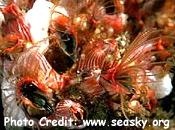
By Bob Goemans


Likely Reef Tank Suitable
Likely Fish-Only Tank Suitable
These are distantly related to crabs and lobsters and are sometimes found attached to live rock, corals, and other invertebrates that enter the aquarium. Barnacles, the only sedentary crustaceans, live in shells of fused plates permanently fastened to any hard substrate whether metal, wood, stone, turtle backs, or whale skin.
They have two larval stages with the first called the nauplius. It is part of the plankton, which is governed by the wind, waves, currents, and tides while it feeds and molts. This only takes about two weeks, then the second stage is reached at which time the nauplius metamorphoses into a non-feeding, more strongly swimming cyprid larva. They in turn, try to find a suitable place to settle down where the environment suits them. If they do, they grasp onto the surface with their short antennae and undergo a metamorphosis by rotating forwards and over so that the swimming legs point upwards. The carapace of the larva then splits a number of times depending upon the species and forms plates we see as shells. If a suitable resting place is not found, the larvae die.
They do well in rough water, and require very good water circulation. Barnacles feed by beating their feather-like legs, called cirri, which in turn draw plankton from the passing water. Probably one of the more interesting genera for aquarists is Lepas and possibly the volcano shaped barnacles that encrust rocks in intertidal zones, such as those in the Family Tetraclitidae. However, they are extremely difficult to maintain, and are probably better left in the wild unless you're willing to provide the environment needed.
© 2012 Bob Goemans. All rights reserved.
The material on this site may not be reproduced, distributed, transmitted, cached or otherwise used, except with the prior written permission of Bob Goemans.

